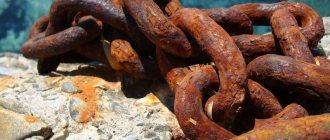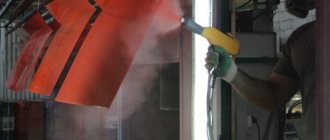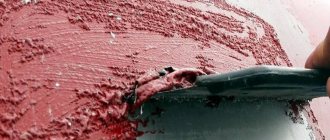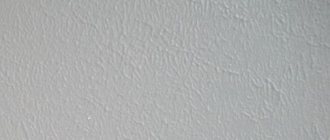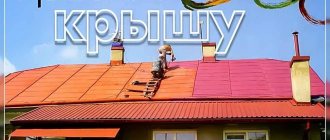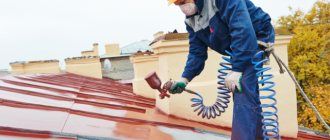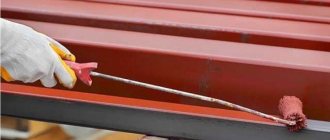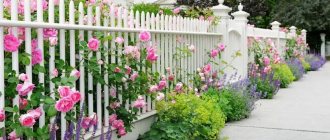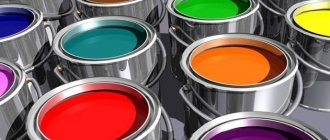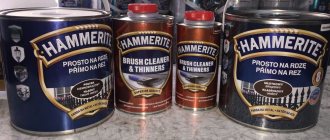Despite another jump in prices on the paint and varnish market in 2021, the demand for construction paints is showing strong growth, according to Rosstat. What roof paints are most popular among Russian consumers, despite their 5–6% annual rise in price? The editors of the Yanashla website have prepared a review of the best paint and varnish products for roofs for 2021 in terms of price-quality ratio.
Features of roofing paints
Roof paints have a wide range of functionality. There are several important criteria for choosing paint products of this type:
- It is necessary that the paint material be resistant to temperature fluctuations.
- The product must not be subject to biological damage.
- It is good if the paint has a minimum drying time.
- It is also required that it has good adhesion.
- It is important that the material contains no harmful components.
- Roofing coatings must have good anti-corrosion properties.
Resistance of paints and varnishes to temperature fluctuations
Heat resistance is a very important property of a paint and varnish material, since paint with good resistance to temperature fluctuations will serve its owner for many years. Currently, special antifreezes or flame retardants are added to many paints, which greatly increase the heat resistance of the material.
Resistance of coating materials to biological damage
To reliably protect the roof of a house from biological damage, you should choose roof paints with antiseptic additives. Among antiseptic paints, not all are suitable for external use, but there are paints and varnishes that are not afraid of aggressive environmental influences. Popular models from the best manufacturers of this type are the antiseptic paint product “Sputnik” or paint “Tent-V”.
Paint drying speed
The faster the product dries, the less foreign substances such as dust, dirt, and moisture will get into it. Therefore, it is important to know how to choose an enamel primer that has a fast drying speed. The champions in drying speed are acrylic and water-based paints and varnishes.
Adhesion of roofing coatings
Adhesion is the ability of a paint and varnish material to reliably adhere to a surface. Products that have good adhesion do not tend to peel, peel off from the painted surface, or split. To check the level of adhesion of paintwork materials using available means, it is enough to apply a grid of square cuts to the paintwork material using any thin object. Next, we glue the tape to the grid of cuts, and then sharply tear it off from the surface of the product - the number of squares that will remain on the tape will indicate the level of adhesion of the paintwork material. The fewer squares left on the tape, the better the adhesion.
Compound
Do not forget that paints and varnishes are chemical substances that contain components harmful to human health. Solvent vapors, aerosol, as well as toxic gases that are released from paintwork materials when it burns are just a few that can cause harm.
Anti-corrosion properties of paint and varnish products
Metal roofing, like no other part of the house, is susceptible to corrosion due to frequent contact with moisture in the form of rain, snow, and hail. It is this feature of the roof that makes us pay close attention to the anti-corrosion properties of roofing paints and varnishes. Galvanized paints with corrosion protection are popular. They significantly extend the service life of galvanized roofing.
Requirements for paint for roofing work
Roofing paint must meet the following requirements:
- resistance to precipitation and other adverse factors;
- sufficient elasticity;
- the ability to expand when heated without losing its original properties;
- uniform color that does not fade under the influence of the sun;
- Suitable for various types of roofing materials, including ferrous metal.
An important quality of roofing paint is the presence of anti-corrosion properties. To treat the roof, it is recommended to use materials that can be applied at low (but not negative) temperatures.
Expert opinion
Zakharova Irina Yurievna
Cleaning professional with 15 years of experience. Our best expert.
Ask a Question
When repairing the roof, quick-drying paint should be used. In this case, work can be carried out more quickly.
Types of roofing paints and what to look for
At the moment, the following types of paints and varnishes for roofs are common on the market of paints and varnishes:
- acrylic coatings;
- alkyd products;
- oil paints and varnishes;
- paints with anti-corrosion components.
Acrylic paints and varnishes
The popularity of acrylic paint models is explained by their durability and strength. This type of paint can last for decades. Their main disadvantage is considered to be high cost, but you will have to buy acrylic much less often than oil or alkyd paints and varnishes.
If you don’t know which type of paint and varnish is best to buy, choose acrylic paints and varnishes - they are considered the highest quality.
Alkyd coatings
Alkyds are not heat resistant. Such paints and varnishes quickly fade, fade or fade. If you use an alkyd product, you need to be prepared for the fact that you will have to change the paint layer of the roof often. It is much more practical to use mixtures based on alkyd material. For example, an alkyd-urethane mixture or coatings of this type containing zinc for galvanized roofs will serve its owner much longer.
Oil paints for roofing
This type has low heat resistance. With frequent temperature fluctuations, paintwork quickly cracks. The material quickly fades or fades. The average service life of the product does not exceed 2–3 years. Paintwork materials do not tolerate exposure to sunlight well. One of the advantages of paints and varnishes is its low cost, since these are mainly budget types of paints. They are distinguished by their aesthetic appearance, as well as the ease of applying the material to the roof surface.
Products containing anti-corrosion components
Such materials are designed specifically for metal roofing. They can be made on the basis of acrylic, oil or alkyd paints and varnishes, the best of which can last for decades. Due to the presence of synthetic resin in such paints, they dry quickly, which significantly reduces the possibility of foreign substances such as dust, dirt, and moisture getting into the paintwork.
Roof paint application area and composition
The rubber effect is used quite often: swimming pools and even cars are treated with this paint. But this paint received greater recognition from builders. It is not only used to treat roofing, but is also used for waterproofing basements, foundations and other hard-to-reach areas that cannot be covered with rolled materials.
Features of the composition and importance of additives
The composition of roof paint includes a huge number of components and additives that help withstand the negative effects of the environment in the form of temperature changes and precipitation.
Depending on the manufacturer, the composition sometimes changes, but the basics remain the same:
- Polymer emulsion.
- Water.
- Latex based on acrylic.
Individual additives help achieve the following properties:
- Antifreeze – resistance to freezing.
- Biocide – prevents the formation of mold.
- Coalescent – forms a film.
- Preservatives – increase shelf life.
- Pigments – give the desired color and shade.
Capabilities and scope
To be sure that buying acrylic roof paint is really the right move, consider how appropriately you can apply this type of paint coating:
- Preventative measure against corrosion.
- Further protection of the metal if corrosion has already formed.
- External roof waterproofing.
- Improving the appearance if the coating is already old and faded.
- Savings: the cost of painting, rather than completely replacing the coating.
Because of this, if you decide to keep your roof in good condition for as long as possible, we strongly recommend covering it with a protective compound to prevent possible problems.
Paints for different types of roofs
Depending on the material used in the construction of the roof, the roofs of houses are divided into:
- metal roofs;
- metal roofing;
- slate roofs.
There are many building materials for roofing on the construction market, but these types of roofs are the most common.
Metal roof painting
Metal roofs are inexpensive and are distinguished by their practicality, which makes them very popular among owners of residential buildings. If you don’t know how to paint an iron roof, it won’t be a mistake when choosing paint materials to purchase acrylic paints and varnishes, which have a number of advantages:
- independence from weather conditions;
- quick drying;
- uniform coverage;
- good adhesion.
It doesn’t matter which company is better, it is important that the paint product for metal roofing has anti-corrosion properties and also has good heat resistance.
Paintwork for metal tile roofs
Despite the fact that high-quality metal tiles do not need painting, there are many paints on the paint and varnish market that are suitable for this type of roofing material. What types of paints are there for metal tile roofing?
- acrylic coatings;
- alkyd products for metal roofs;
- oil paints.
Aerosol cans are well suited for painting in sunny, windless weather. It is necessary to apply paintwork in several layers perpendicular to the surface to be painted with even zigzag movements.
For slate roofing
A distinctive feature of slate is its heat resistance, which makes this material no less popular than metal in roofing construction. Slate also has properties such as increased fire resistance and water resistance. However, asbestos dust, which begins to cover this type of building material over time, as well as small cracks that form on the surface of slate, are its undeniable disadvantages.
To paint slate, the following paint and varnish materials are used:
- acrylic coatings;
- special slate enamel;
- liquid plastic.
Particularly worth highlighting is slate enamel. Slate enamel has good adhesion and is subject to minimal exposure to ultraviolet rays.
Slate painting
A slate roof is painted for only one reason - to give it a more presentable appearance. For this it is better to use silicone or acrylic paints and enamels. And here it doesn’t matter whether they are water-based or diluted with organic solvents. But it should be noted that the second option has higher positive characteristics:
- the film formed on the surface is more durable;
- high water-repellent qualities;
- increased elasticity ;
- resistance to ultraviolet radiation ;
- color longer .
The only negative is the pungent odor, which disappears after the applied layer dries. Although for outdoor work this factor is not decisive.
The material is first treated with a primer, which closes the pores on the surface. It is better to paint with a brush with stiff bristles. In this case, the roller is completely inappropriate; it cannot paint the lower waves (at least it’s difficult). It is easier to paint slate that is lying on the ground and has not yet been installed. It’s more difficult with one that is already attached to the rafter system.
Painting slate should be done carefully - slate is a fragile material Source decorexpro.com
The best acrylic paints for roofing
DALI, rubber, 3 kg.
The paint and varnish material is intended for painting roofs, facades, plinths, etc. This paint and varnish product is suitable not only for exterior painting, but also interior painting. The material easily withstands high and low temperatures both outside and indoors. Paint is not afraid of high humidity either. Primer-enamel is best suited for slate and tile roofing, as well as for painting concrete products, drywall, various wood materials, chipboard, metal surfaces, etc.
The average price is 1000 rubles.
DALI paint, rubber, 3 kg.
Advantages:
- low cost;
- high quality;
- good adhesion;
- durability;
- used indoors and outdoors;
- resistance to mechanical stress;
- heat resistance.
Flaws:
- Not found.
Novbytkhim, slate roofing, 10 l.
Paintwork materials are well suited for roofs made of mineral materials, such as slate, tiles, concrete, brick, etc. Primer enamel is subject to minimal exposure to ultraviolet radiation, has good adhesion and is not afraid of bad weather conditions, in particular wind, snow and rain. The material has good resistance to biological damage. The paint prevents the appearance of lichen, moss, and various algae on the roof. The average service life of paints and varnishes is five years, which, for example, is one and a half to two times longer than that of oil-based paints.
The average price is 2300 rubles.
Novbytkhim paint, slate roofing, 10 l.
Advantages:
- resistance to biological damage;
- does not change its color (does not fade, does not become dull, etc.) after painting;
- has low toxicity;
- good fire-resistant properties;
- quick drying;
- can be diluted with water;
- low cost.
Flaws:
- Not found.
NEOMID MASTER GOOD, rubber, 14 kg.
The material is recommended for repairing roofs made of tiles, concrete, brick, slate and ferrous metal. The product is not afraid of high humidity, so paint and varnish materials can also be used in interior areas of the house, such as bathrooms, kitchens, basements, etc. The paint has good adhesion. Before using a paint product, the surface to be painted must be cleaned of foreign substances: dust, dirt, rust, etc. The use of primer-enamel is not allowed in bad weather conditions: wind, rain, snow, fog. The surface can be painted with a sprayer, brush or roller.
The average price is 4000 rubles.
NEOMID MASTER GOOD paint, rubber, 14 kg.
Advantages:
- quick drying;
- elasticity;
- good adhesion;
- eliminates cracks on the painted surface;
- good vapor permeability;
- durability (average service life - 8 years);
- low cost.
Flaws:
- Not found.
Rating of the best paints for rust
When compiling the rating, various characteristics of the samples under consideration were taken into account, incl. reviews, place of use, temperature of painting and operation, application methods, adhesive properties, and many others. However, primary attention was paid to the presence of positive feedback, the ratio of product quality and cost, as well as the popularity of the models in the opinion of buyers.
TOP 3 best anti-rust paints for exterior use
Teknos Ferrex
The rating of high-quality paints and varnishes reveals a universal material for processing aluminum and steel products. It has adhesive properties on galvanized (galvanized) surfaces, as well as areas treated with shop primers.
Used for priming metal products operating under increased load and negative atmospheric influences, incl. for the surface or underwater parts of boats.
The composition contains additives against mold formation.
Characteristics:
| Parameter | Meaning |
| Dry residue | up to 43% |
| Coating | matte |
| Density, g/ml | 1.25 |
| Drying time, h | 3-6 |
| Consumption, sq.m/l | 10 |
| Diluent | Teknosolv 1621 |
| Work tool | sprayer, brush, roller, sponge |
| Packaging, l | 1,0; 3,0; 10,0 |
| price, rub. | 1200; 3540; 10340 |
| Brand | Teknos |
| Manufacturer country | Finland |
Teknos Ferrex
Advantages:
- resistance against negative atmospheric influences;
- high solids;
- possibility of processing galvanized or aluminum surfaces;
- painting for stubborn rust;
- antifungal properties;
- can be used as a finishing agent.
Flaw:
- high price.
DuLux Master 90
Universal paint for application to metal structures. Provides the creation of a weather-resistant elastic coating that is resistant to sudden changes in temperature and humidity. It has water-dirt-repellent and adhesive properties that can withstand prolonged temperature exposure up to +90 degrees.
When repairing, apply with a brush or roller in two layers at a temperature of 5-30 degrees and a humidity of 40-80%.
Characteristics:
| Parameter | Meaning |
| Coating | glossy |
| Drying time, h | 12 - first layer; 16-24 - full |
| Consumption, sq.m/l | 8-12 |
| Diluent | White Spirit |
| Work tool | brush, roller |
| Packaging, l | 0,9; 1,0; 2,5; 10 |
| price, rub. | 850; 1160; 2550; 9650 |
| Brand | Dulux, AkzoNobel |
| Manufacturer country | Netherlands |
DuLux Master 90
Advantages:
- quick-drying;
- does not leave streaks;
- no splashing;
- ease of painting.
Flaws:
- inadmissibility of work at negative temperatures;
- Laundering requires effort.
Neomid Master Good
Ready-to-use, highly elastic material for processing galvanized and aluminum surfaces, as well as ferrous metal structures. During construction, you can paint roofs and drainage systems. Resistant to the negative effects of climatic conditions (ultraviolet, precipitation) with good water resistance. Has a high degree of elasticity and does not crack. Construction paint is applied in two layers.
Long service life up to 10 years.
Characteristics:
| Parameter | Meaning |
| Coating | rubber |
| Drying time, h | 3-4 |
| Consumption, sq.m/l | 7-10 |
| Diluent | water |
| Work tool | sprayer, brush, roller |
| Packing, l | 2,4; 14,0 |
| price, rub. | 850; 3990 |
| Brand | MasterGood |
| Manufacturer country | Russia |
Neomid Master Good
Advantages:
- pleasant to the touch;
- easy to clean;
- attractive price;
- quick drying.
Flaw:
- Prolonged contact with water is not allowed.
TOP 3 best paints for rust “3 in 1”
Husky Klondike
Material from a domestic manufacturer is applied to metal structures indoors and outdoors. Treatment of the corroded surface is carried out after removing loose rust. Thanks to the components included in the composition, corrosion is converted into a reliable protective layer, its further development is inhibited, and a weather-resistant film is formed. If the instructions are followed, metal protection is provided for up to eight years.
Characteristics:
| Parameter | Meaning |
| Coating | glossy, semi-matte |
| The basis | alkyd |
| Color | 26 colors |
| Drying time, h | 4-6 |
| Consumption, sq.m/l | 10 |
| Diluent | orthoxylene |
| Work tool | sprayer, brush, roller |
| Packaging, l | 0, 25; 0,9;2,5 |
| price, rub. | 243; 559; 1469 |
| Brand | Descartes (Russia) |
| Manufacturer country | Russia |
Husky Klondike
Advantages:
- good hiding power;
- high adhesive properties against rusty metal;
- creates a smooth surface or hammer effect;
- dries quickly;
- tinting according to MONICLOR, Spirit, RAL, NCS catalogs.
Flaws:
- Strong smell;
- the need for ventilation when working indoors.
Tikkurila Metallista
A special weather-resistant material that combines a rust converter, an anti-corrosion primer and a decorative topcoat. Provides easy painting of cast iron and steel areas without the need for additional primer. The presence of wax prevents the penetration of moisture. May be used in preschool or medical institutions.
Tikkurila computer tinting available.
Characteristics:
| Parameter | Meaning |
| Dry residue | up to 60% |
| Coating | glossy |
| Color | according to the catalog |
| Drying time, h | 6-10 |
| Consumption, sq.m/l | 10-13 |
| Diluent | white spirit 1050 |
| Work tool | sprayer, brush, roller |
| Packaging, l | 0, 4; 0,9;2,5 |
| price, rub. | 348; 729; 1890 |
| Brand | Tikkurila |
| Manufacturer country | Finland |
Tikkurila Metallista
Advantages:
- weather resistance;
- excellent wear resistance;
- double formula;
- prevents the spread of corrosion;
- applied directly to rust;
- withstands the effects of turpentine, white spirit, fats, oils, and thick lubricants.
Flaws:
- highly flammable material;
- it is prohibited to inhale vapors;
- the largest capacity is 2.5 liters;
- thoroughly ventilate the room;
- high price.
KrasByt Anticorro-Plus
Quick-drying all-season anti-corrosion material made in Russia with the addition of components that transform rust. Has high protective and decorative properties. Used for painting ferrous and non-ferrous metals directly over rust. Provides protection of reinforced concrete products from harmful atmospheric factors and corrosion.
Characteristics:
| Parameter | Meaning |
| The basis | acrylic silicone |
| Coating | matte |
| Color | tinting according to RAL |
| Application temperature, degrees | -15-+60 |
| Drying time, h | 3 |
| Consumption, kg/sq.m | 0,1-0,3 |
| Diluent | butyl acetate |
| Work tool | sprayer, brush, roller |
| Packaging, kg | 25 |
| price, rub. | 6380 |
| Brand | KrasByt |
| Manufacturer country | Russia |
KrasByt Anticorro-Plus
Advantages:
- quick drying;
- good weather resistance;
- high heat resistance;
- easy application;
- neutralizes the corrosion process;
- long service life.
Flaws:
- mandatory thorough ventilation of the work area;
- the need for personal protective equipment;
- Highly flammable, must be kept away from fire.
TOP 3 best paints for hammer rust
Dali hammer
Products from a domestic manufacturer for treating cast iron, steel, non-ferrous or galvanized surfaces directly against metal and rust. Provides a “hammer” effect. With the function of converting corrosion, primer, and decorative enamel. It has a three-stage protection system - barrier, anti-corrosion, tread.
Characteristics:
| Parameter | Meaning |
| The basis | alkyd |
| Coating | glossy |
| Color | 9 basic |
| Application temperature, degrees | from +8 |
| Drying time, h | touch-free - 2; final - up to 7 days |
| Consumption, sq.m/l | 12-18 |
| Diluent | Dali, solvent, xylene |
| Work tool | sprayer, brush, roller |
| Packaging, kg | 0,23; 0,75; 2,0; 10,0 |
| price, rub. | 277; 630; 1480; 6800 |
| Brand | Dali (Russia) |
| Manufacturer country | Russia |
Dali hammer
Advantages:
- high adhesive properties to rusty surfaces;
- direct application to rust with the effect of the “3 in 1” formula;
- durable layer with hand-hammered effect;
- water resistance;
- resistance to oils, weak alkalis and acids;
- alkyd based, not exposed to ultraviolet radiation;
- weather-resistant to sudden temperature changes;
- excellent hiding power;
- low consumption;
- affordable price.
Flaw:
- the need to paint in several layers with the obligatory drying of each.
More information about paint in the video:
Material for protective and decorative treatment of reinforced concrete and metal products indoors and outdoors. The coating has excellent adhesive properties to rusty surfaces. It has the best physical and mechanical properties - impact resistance, weather resistance, non-abrasion. Apply to areas previously cleaned of loose corrosion.
When painting galvanized areas, an additional primer is required.
Characteristics:
| Parameter | Meaning |
| The basis | alkyd |
| Coating | glossy |
| Color | tinting according to catalog |
| Application temperature, degrees | +5-+30 |
| Drying time, h | 6 |
| Consumption, sq.m/l | 8 |
| Diluent | White Spirit |
| Work tool | sprayer, brush, roller |
| Packaging, kg | 0,25; 0,75; 2,3 |
| price, rub. | 290; 630; 1560 |
| Brand | Panzer |
| Manufacturer country | Serbia |
Panzer for metal hammer
Advantages:
- painting directly over rust using the “3 in 1” method;
- convenient packaging;
- beautiful appearance;
- excellent hiding power;
- good price/quality ratio.
Flaw:
- Strong smell.
Hammerite with hammer effect
Material using DualTech technology from the recognized international leader in paint and varnish production from the Netherlands. Provides an interesting decorative “chasing” effect, concealing unevenness and camouflage in areas to be touched up in case of damage. Aluminum flakes in the composition create a unique pattern, and specific silicones with the addition of wax give a water-repellent effect. They are used for anti-corrosion protection and final finishing of metal gates, fences, gratings, as well as furniture.
Characteristics:
| Parameter | Meaning |
| The basis | alkyd |
| Coating | glossy, semi-matte |
| Color | 12 basic |
| Painting temperature, degrees | +15-+30 |
| Drying time, h | 4 |
| Consumption, sq.m/l | 10 |
| Diluent | Hammerite |
| Work tool | sprayer, brush, roller |
| Packaging, kg | 0,25; 05; 0,75; 2,2; 2,5; 5,0; 20,0 |
| price, rub. | 466; 702; 1050; 2550; 2950; 16730 |
| Brand | Hammerite, AkzoNobel (Netherlands) |
Hammerite with hammer effect
Advantages:
- direct application to rust;
- unique “3 in 1” formula;
- reliable anti-corrosion protection for up to 12 years;
- weather-resistant layer with water-dirt-repellent properties;
- quick drying;
- excellent hiding power;
- good adhesive properties to corrosive areas.
Flaws:
- not suitable for metal products located in an aquatic environment;
- high price;
- the need for proprietary Hammerite solvent.
More information about painting with this composition is in the video:
Material for treating clean or corroded surfaces. Characterized by fast drying. Apply directly to rusty areas. Combines the properties of transforming corrosion, primer and decorative enamel. The presence of anti-corrosion pigments prevents the development of corrosion.
Characteristics:
| Parameter | Meaning |
| The basis | alkyd |
| Coating | matte |
| Color | 12 |
| Application temperature, degrees | from +5 |
| Drying time, h | 6 |
| Consumption, sq.m/l | 10 |
| Diluent | solvent No. 1, xylene, R-4, R-5 |
| Work tool | sprayer, brush, roller |
| Packaging, kg | 0,4; 1,0; 3,0; 20,0 |
| price, rub. | 155; 295; 855; 5600 |
| Brand | Novbytkhim |
| Manufacturer country | Russia |
Novbytkhim primer-enamel
Advantages:
- dries quickly;
- high weather resistance and immunity to sudden temperature changes;
- resistance to salt water and mineral oils;
- elasticity;
- adhesive properties to metal;
- excellent hiding power;
- ability to work at negative temperatures down to -10 degrees;
- good price/quality ratio.
Flaws:
- Strong smell;
- is capricious when using a solvent.
Video tutorial on working with paint:
Vixen primer-enamel for rust
Aerosol composition for treating metal, glass, stone and wooden surfaces. Reliably adheres to structures affected by corrosion, preventing further spread. After painting, the appearance of the product is renewed.
Characteristics:
| Parameter | Meaning |
| Coating | semi-matte |
| Color | 9 according to RAL standard |
| Painting temperature, degrees | +5-+30 |
| Drying time, h | 7 |
| Consumption, sq.m/piece | 2,5-4,5 |
| Work tool | aerosol can |
| Volume, ml | 520 |
| By price, rub. | 196 |
| Brand | Vixen |
| Manufacturer country | Russia |
Vixen primer-enamel for rust
Advantages:
- convenient application;
- good hiding power;
- quick drying;
- fine spray;
- efficiency;
- low cost.
Flaws:
- Strong smell;
- toxicity;
- There are questions about efficiency and consumption.
The best alkyd paints for roofs
Tikkurila Panssarimaali, for metal roofing, 0.9 l.
Branded paint and varnish product of European quality is used for a variety of metal structures, including coatings intended for metal roofing. Due to its specificity, the material has enhanced anti-corrosion properties. It has an average drying speed of approximately 3–5 hours. It is recommended to start applying the second layer of the product after 24 hours. The paint has good weather resistance, since it is not afraid of either high humidity or other bad weather conditions.
The average price is 750 rubles.
Tikkurila Panssarimaali paint, for metal roofing, 0.9 l.
Advantages:
- ease of operation;
- does not have a pronounced unpleasant odor;
- durability;
- resistance to mechanical damage;
- weather resistance;
- good adhesion;
- heat resistance.
- good anti-corrosion properties.
Flaws:
- average drying speed.
TEKNOS Kirjo, 0.9 l.
Not the last place in the ranking of high-quality alkyd paints for roofing is occupied by a paint product from a Finnish manufacturer, which has pronounced anti-corrosion properties, since it is intended for painting metal structures. The material is also well suited for galvanized roofs. Average drying time is five hours. You can begin applying the next layer after 16–18 hours. Paintwork materials should be used in favorable weather conditions. When the temperature of the surface to be painted is above 50 degrees Celsius, the use of TEKNOS Kirjo paint and varnish product is not allowed.
The average price is 1000 rubles.
paint TEKNOS Kirjo, 0.9 l.
Advantages:
- contains anti-corrosion pigments;
- long service life;
- easy to apply to the surface to be painted;
- weather resistance;
- resistance to mechanical stress.
Flaws:
- weather dependence (increased sensitivity to adverse weather conditions);
- high price.
Optimist F 310, for facade and interior work
A paint product made on the basis of acrylic latex is characterized by increased weather resistance, vapor permeability and elasticity. The material is intended for painting roofs, drainpipes, building facades and plinths. When using paints and varnishes, you need to ensure that no foreign substances get into the paintwork product, i.e. it is necessary to protect the product from clogging, otherwise the quality of the paintwork will decrease significantly. To apply paint to the surface to be painted, it is allowed to use a spray gun, roller or brush. The product is tinted manually, as well as on tinting machines using water-dispersed dyes. The weight of the paintwork is 7 kg. The material can be easily purchased in the online store.
The average price is 2000 rubles.
paint Optimist F 310, for facade and interior work
Advantages:
- low cost;
- ease of operation;
- does not crack;
- does not peel off;
- has no unpleasant odor;
- non-toxic;
- good fire-resistant properties;
- environmentally friendly product.
Flaws:
- Not found.
Application recommendations and interesting facts
Failure to follow the recommendations for applying acrylic paints may result in the desired result not being achieved. The rubber coating may peel off immediately after application or upon initial contact with water/moisture. Before applying, carefully read all the points and try to do everything according to the instructions.
General recommendations
To paint a roof, you need to know how to work with rubber roof paints. This is quite capricious material that needs to follow all the rules. The weather in which you want to start working matters a lot. If there is wind or rain, it is better not to start work, but bright sunshine is also contraindicated. Ideally, the temperature range should be from +10 to +25 degrees. Air humidity that is more than 80% is extremely undesirable.
To check the hiding power and select the number and thickness of applied layers, you must first paint the sample. To do this, we advise you to select a small, inconspicuous area of the roof, prepare the surface and apply several layers at time intervals. This method will help you avoid critical mistakes, which, if the price of the material is high, will cost you a pretty penny.
A common mistake is the desire to apply thick layers. In a situation with acrylic paints, it is better to apply more thin layers with drying intervals than one thick one. This way you can increase resistance and the coloring will be more durable.
Roof painting tools
In order to work on the roof without harm to yourself and others, you should follow safety precautions.
To cover your roof with rubber paint you will need the following:
- Mounting belt (safety).
- Shoes with non-slip soles.
- Helmet.
- Ladder.
- Respirator and safety glasses.
- Brushes and rags to clean the surface.
- Metal brush (if the coating is metal).
- Sandpaper.
- Primer.
- Construction mixer.
- Roller, brush or spray gun.
This is the perfect tool kit for working with acrylic paint on your roof. Thanks to this, you can take care of safety, properly prepare the roof for painting and apply the paint as efficiently as possible.
Preparation
You should start with preparation. Regardless of what roofing material you paint, it should be thoroughly cleaned of dust, dirt, grease and paint residues. Galvanized corrugated sheeting or metal roofing should be thoroughly washed and the old paint should be removed with a metal brush. If rust has formed, it must also be removed with sandpaper or a brush. The slate roof is washed with water and debris is removed.
If there are any unevenness, they need to be filled. Grease stains are removed with white alcohol. Next, we sand everything with sandpaper and remove the resulting dust. After the roof is washed, the roof is painted with rubber paint only after it has completely dried.
To reduce paint consumption, the surface is pre-primed. This especially applies to porous materials, for example corrugated sheets or asbestos cement flat sheets. The primer should be applied with a roller or spray gun. The next stage of work can begin after complete drying.
Application technology
Rubber roof paint is not at all difficult to apply to the prepared surface. Depending on the type of roof, you can cover the surface with paint using a sprayer, brush or roller.
First, rate the purchased material. We do not recommend thinning the paint on acrylic, but if the density does not suit you, you can thin it with an acrylic primer. The most important thing is not to use drying oil or other oil-based solvents.- Next, we carry out a test staining on an inconspicuous area.
- Apply the first layer to the roof surface.
- Let the material dry. According to the technical characteristics, the drying time of the layers should be indicated.
- Next, apply another thin layer. If necessary, you can increase the number of layers.
- 12 hours after application the roof is ready for use.
- Do not wet the surface for the next week.
The best oil paints for roofs
Super Decor, 1 kg.
A product with good waterproofing properties is little susceptible to abrasion and is specially designed for decorative and protective finishing. There are a lot of positive reviews about Super Decor on the Internet. Paintwork materials have increased resistance to washing. Paintwork materials can be used for both external and internal work. This acrylic dispersion material can be diluted with water and tinted. Any paste for water-based paints is suitable for tinting. The paint product dries to a solid state in an average of 1.5–3 hours. The shelf life of unopened product packaging is two years. You can find out how much large-volume paintwork materials cost on the manufacturer’s website.
The average price is 350 rubles.
Super Decor paint, 1 kg.
Advantages:
- waterproof;
- non-toxic;
- without smell;
- good adhesion;
- low cost;
- abrasion resistance;
- elasticity.
Flaws:
- high consumption of material.
LAKRA MA-15, 0.9 kg.
The basis for the production of Lakra Ma-15 coatings is linseed oil. The product is ideal for roofing and basement. Has good weather resistance. The product can be used for internal and external work. It is not recommended to use this paint and varnish material when painting floors. Before applying the product to the surface to be painted, it must be cleaned of foreign substances. Do not apply paintwork over rust. There are also recommendations to degrease the surface with a solvent and soak it with drying oil. In unopened packaging, the material can be stored for at least 18 months. Complete drying time is 24 hours. During work, it is allowed to use a sprayer, brush or roller.
The average price is 200 rubles.
paint LAKRA MA-15, 0.9 kg.
Advantages:
- low cost;
- weather resistance;
- used for external and internal work;
- ease of operation.
Flaws:
- takes a long time to dry.
MA-15 Prosvet, 20 kg.
The paintwork material has a pronounced glossy sheen. The product can be used when painting metal and wooden surfaces. The material is intended for external and internal finishing works. The average paint consumption is 1 kg. paints for 5–7 sq.m. surface to be painted. Before applying the paint product to the surface, it is necessary to clean it of old paintwork (if any) using a scraper and sand it. After sanding, be sure to remove all dust and other foreign matter. The product must be mixed before use, and it is also necessary to remove a layer of film, if any has formed during storage.
The average price is 1800 rubles.
paint MA-15 Rastsvet, 20 kg.
Advantages:
- low cost;
- ease of operation;
- can be used indoors and outdoors;
- good adhesion.
Flaws:
- Has an unpleasant odor.
Popular questions
For which roof should I use rubber paint?
Acrylic paint coating is suitable for all the most popular types of roofs, and for some of them it is even necessary. Metal tiles are treated with an anti-corrosion coating during production, but this coating is short-lived, which nullifies the manufacturer’s guarantee of durability. But if such a coating is painted from time to time with special roof paint, you will extend its service life.
But a material like slate does not rust, but this does not mean that it is eternal. It is easily saturated with moisture, which is why it becomes brittle and collapses. The waterproofing properties of acrylic paint make such sheets resistant to water and moisture.
Galvanized roofs are afraid of salts, which should be taken into account with the fact that the coating easily enters into chemical reactions and self-destructs. Considering the state of the environment, galvanized sheets are constantly under negative influence. Snow, rain, and even car exhaust gases can damage such a roof. Rubber roof paint will help in this case too.
You can even paint a soft roof with paint based on acrylate latex. Rolled soft roofing is short-lived, easy to damage, and quickly dries out and cracks. To “bring back to life” a roof that is covered with roofing felt, paint it with moisture-proof paint, and it will last you much longer.
All the pros and cons: compelling arguments
With a wide variety of building materials in the paint and varnish department, it is very easy to get confused. The difference in price between seemingly similar paints makes you think, what exactly is the difference? To make the right choice and understand whether it is worth buying rubber roof paint, let's compare all the advantages and disadvantages. A brief overview of the most popular brands will allow you to make the right choice.
Advantages
Judging by numerous reviews, there are many more pros than cons. The advantages include:
- Durability.
- Drying speed.
- Resistance to negative environmental influences.
- Easy to apply and further use.
- Good hiding power.
- Elasticity.
- Safety.
- Anti-slip property.
- Suitable for coloring any material.
Yes, rubber based paint does have many benefits. The service life of the applied paint coating reaches 7 years or more. The paint will not deteriorate due to temperature changes, retains water well, and does not contain harmful impurities, as it is made on a water basis. Applying the paint is easy, and you can use either a brush or a roller for the job. The adhesion of this paint to any type of coating provides good coverage. Even the first layer has no gaps and looks dense. An important plus is that it dries in just a few hours. It is also important that the surface does not slip after coating.
Flaws
Such roof paint is much more expensive than conventional oil or alkyd analogues. This is what scares off most buyers. But keep in mind the fact that acrylic paint will last you much longer, which means that coating with cheap paint will be done more often, and the price will be the same.
Another significant disadvantage is that the surface must be carefully prepared before painting. Of course, such procedures must be carried out before painting of any kind, but when using acrylic products this is especially important. Sometimes it is quite difficult to completely treat the roof, especially when it comes to covering old roofing materials.
How to choose and not make a mistake?
To avoid making a mistake when choosing paint, consider a number of factors that are of great importance:
- Manufacturer . Make a choice only in favor of quality manufacturers who provide quality certificates. Such companies value their reputation and strictly adhere to technology when creating paint and varnish coatings. We recommend reading customer reviews before purchasing.
- Paint consumption per 1m2 . The declared paint consumption is also of great importance, since this will not only help determine the amount of material that should be purchased, but will also help determine the quality of the product. The lower the paint consumption, the less it was diluted with water.
- Drying time . If you decide to buy material “as a spare”, do not forget that rubber roof paint does not last as long as you would like. If you store the paint in a closed container, the temperature should not exceed +30 degrees. Some manufacturers offer paint in 1 liter containers. If you need large volumes, it will be more profitable to buy in large packages at once.
Comparison in the table
Below is a table of the most popular brands of acrylic roof paint. This will help you make a choice.
| Manufacturer (country) | Russia | Ukraine | Russia | Russia | Greece | Türkiye |
| Consumption per 1 layer | From 100 to 200 ml/m2 | From 100 to 200 g/m2 | From 126 to 200 g/m2 | From 150 to 200 g/m2 | From 85 to 110 ml/m2 | From 91 to 133 ml/m2 |
| Touch-drying time | 1 hour | 2 hours | 2 hours | 2 hours | 1 hour | 2 to 3 hours |
| Best before date | 12 months | 18 months | 18 months | 12 months | 12 months | 24 months |
| Packaging options | 7/14/18 kg | 1.2/3.5/6/12 kg | 1/3/6/12 kg | 4.5/7/14/45 kg | 3/10 l | 2.5/15 l |
| Price/liter | From 250 rubles | From 200 rubles | From 300 rudders | From 230 rubles | From 500 rubles | From 700 rubles |
1– Rezolikh Upiversal
2 – Farbex
3– Super Decor
4 – Optimist
5 – Isomat Flexcoat
6 – kale Perfora+
The best roof paints with anti-corrosion components
Chief Technologist, rubber, 1.1 kg.
Anti-corrosion primer-enamel, made in Russia, based on latex, with the addition of antifreeze. Designed for protective painting, but can also be used for decorative purposes. Slate, ferrous metal, brick, tiles, chipboard, fiberboard, galvanized iron, etc. are well suited as a painted surface for this paint and varnish product. It is used for both interior and exterior finishing work. The product is characterized by good water resistance and wear resistance, has good elasticity, adhesion, and also prevents the formation of cracks on the painted surface. A full description of the product characteristics can be found on the manufacturer’s website.
The average price is 400 rubles.
Main Technologist paint, rubber, 1.1 kg.
Advantages:
- crack resistance;
- versatility;
- quick drying;
- elasticity;
- good adhesion;
- weather resistance;
- ease of operation.
Flaws:
- Not detected.
Master Good, water dispersion, 2.4 kg.
The average consumption of “Master Good” anti-corrosion primer-enamel is 1 kg. products for 5–6 sq. m of surface to be painted. The composition of the paint and varnish material includes an antiseptic, pigments and a latex composition. The product is not afraid of exposure to bad weather conditions, has good heat resistance and water resistance. According to consumers, the paint product is abrasion resistant. The surface painted with Master Good primer enamel can be safely washed with water and household detergents. If the operating conditions of the paint and varnish product are observed during finishing work, the service life of the material is on average 8–10 years.
The average price is 700 rubles.
Master Good paint, water-dispersion, 2.4 kg.
Advantages:
- elasticity;
- water resistance;
- heat resistance;
- weather resistance;
- not subject to cracking;
- vapor permeability;
- low cost.
Flaws:
- Not detected.
Offers from well-known manufacturers
In the construction market, zinc materials are represented by well-known brands:
- Hammerite paint is applied directly to the rusty surface . The coating is durable and wear-resistant. KM adheres tenaciously to any roofing material and resists the spread of corrosion. The roof is covered with an even, beautiful layer that dries quickly and is resistant to direct sunlight. The range of paints is not limited in shades.
But the dye also has disadvantages: salts appear on the coating; anti-corrosion resistance maximum 4 years; if the degreasing of the roof being painted is not carried out properly, the coating will quickly burst; the formation of small bubbles on the coating layer is the result of working with a roller.
- Many positive technical characteristics of Tikkurila brand paint coincide with Hammerite CM. But there are also advantages. Resistance to natural factors and chemicals is greater in terms of performance. The covering paint layer tolerates heating up to 80°C. Therefore, the coating tolerates heat and adhesion to metal increases. The paint does not lose its qualities at low temperatures.
- Acrylic with a matte tint is used - “Tsikrol” . It contains additives that fight rust. The paint layer is moisture resistant; interacts well and adheres to galvanized steel; does not lose color brightness; dries quickly; tolerates temperatures below zero. Before painting the galvanized roof of a house with Tsikrol acrylic, it is not treated with a primer. After this, adhesion to zinc increases. CM is used sparingly, since it is enough to cover one layer.
- The Russian manufacturer offers KM "Unikom" . Since it is fire-resistant, it is used for painting roofs with increased thermal load.
Polyurethane and alkyl-urethane compositions retain their color brightness for a long time. Apply to old, worn roofs. “Unikom” is supported on a fairly leaky roof if there are only pieces of galvanized coating. The paint adheres well. Refers to inexpensive CM.
- In Russia, enameled anti-corrosion one-component paint for galvanized roofing is produced - “Serebrol” . It is used to paint a steel surface. The basis of the material is aluminum powder. Thanks to it, the protective qualities of CM are increased. It also contains perchlorovinyl and epoxy resins, additives, and organic solvent. KM is moisture-resistant, withstands mechanical damage and exposure to auto chemicals. The roof will be covered with a high-quality coating if the CM is applied in 2 layers. Used to protect roof surfaces in latitudes where natural hazards prevail. The seam roof, galvanized gutters, and drainage pipes are painted. Their wear is reduced by 3 times.
Alkyd enamels and alkyd-urethane materials form a beautiful coating. But they don’t hold up well on a galvanized roof. Before painting the galvanized roof with such paint, additional primer or a “3 in 1” composition is applied.
- In addition to a roof made of galvanized metal, a ventilation system and drains made of the same material need protection. A specialized primer composition for surfaces protected by zinc “Rostex Super” .
We recommend: How and with what to paint fiberglass wallpaper.
Selecting the desired composition based on properties
Let's look at the types of roof paints, why some are good and in what cases others are not suitable.
Thus, one of the main properties of products for painting roofs of houses is resistance to weather conditions. These are exposure to ultraviolet radiation, temperatures, sudden changes in weather and the ability to withstand deformation of the base. For example, metal sheets expand slightly when heated, and the paint should do this along with them. Otherwise, small cracks will quickly appear on the roof and there will be no benefit from such painting.
The appearance of the updated roof is also important. Why there are requirements for the paint composition such as uniform application, uniform color and resistance to fading. And different species differ on these points.
Oil: for budget options
Good old oil-based roofing paint works well on metal roofs and is affordable, but it performs the worst when it comes to weather protection. The oil composition has practically zero elasticity, due to which the painted sheets quickly become covered with cracks and the slopes have to be renewed every 3-5 years. Therefore, this option can be called acceptable only for country gazebos, which will not be difficult to repaint. Although for some people this will even be a pleasure, since from time to time you can change the color of all garden buildings and play with the design.
Alkyd: improved version
A more modern version of classic oil paints is alkyd. They have a similar hardening mechanism, but here alcohols and vegetable oils are used.
For already damaged roofs, alkyd rust paints with zinc particles are suitable. Their alkyd-urethane mixture prevents the spread of deep corrosion, but, however, is not resistant to fading.
That is why they buy this paint for a metal roof with already existing, quite noticeable damage. After all, it is based on special components that seal corrosive stains and prevent them from spreading to healthy metal. Therefore, in the case of such paints, there is no need to specifically remove rust in advance. True, this type is only suitable for roofs in which marks have appeared recently, but it is better to replace severely affected sheets. Here's how this coloring happens:
Acrylic: excellent adhesion
Acrylic compositions for painting roofs based on polyacrylates are considered to be of higher quality. They have elasticity, high adhesion to any surface and resistance to ultraviolet radiation:
Acrylic paints are suitable for metal and slate roofs, although they are more expensive than alkyd ones. But they can extend the service life of the coating up to 25 years! You can also change the composition of such paints yourself to achieve the desired technical properties by adding special additives to them.
The next generation of acrylic paints are anti-corrosion. They already have special components that prevent rust stains from forming. Therefore, there is absolutely no point in purchasing them for slate roofs, since they are not subject to corrosion, and for ferrous metal there is no better paint. And the entire roof should be treated with it even before the first rain, literally immediately after installation:
For example, Tsikrol 2SH paint with a polyurethane composition, UV components and active anti-corrosion additives is popular in this segment.
Rubber paints: high elasticity
The thickness of rubber paint resembles mastic, but when applied to the surface it hardens and forms a strong elastic film, which is stretchy. Some amateurs even shoot videos of how a film is formed, which can be stretched several times with your hands.
The whole secret is that in the production of rubber paint the following components are used:
- water as a solvent;
- acrylate latex for the required elasticity and reliability of the coating;
- coalescent to create a surface film;
- antifreeze to make the roof resistant to cracking during frost;
- preservative for storing paint in a closed container;
- other fillers, thanks to which the necessary technical characteristics and performance properties are achieved.
Due to this composition, rubber paint has an excellent level of adhesion to a wide variety of surfaces, resistance to climatic conditions and even vapor permeability. It is thanks to vapor permeability that it can be applied to wood material.
Even at a temperature of -20 degrees Celsius and air humidity up to 65%, it will still create a durable elastic film. At the same time, the finished roof also has an anti-slip surface with high wear resistance:
The rubber roof paint itself also belongs to the acrylic group, and therefore it is suitable for both metal and slate roofs. In addition to all its positive properties, this composition is characterized by heat resistance, absolute waterproofness and the absence of a toxic odor. Note that rubber paint is safe for health, which is why it is actively used today even on playgrounds.
All rubber roofing paints are similar in composition and application method, which depends on the surface being painted. In the production of the required composition, the need for increased adhesion and even the possibility of application to a vertical surface are taken into account. Today, rubber paint is produced for the roof, base and facade, each of which has its own characteristics.
Please also note that almost all manufacturers today produce an appropriate primer for their paints. That’s why both paint and primer are often released in pairs so that they fit perfectly together and give the desired effect.
